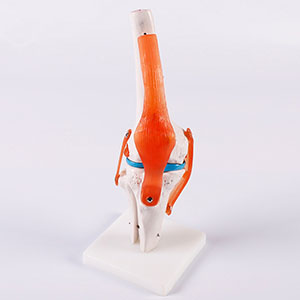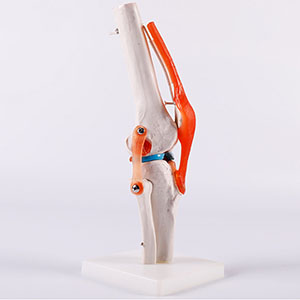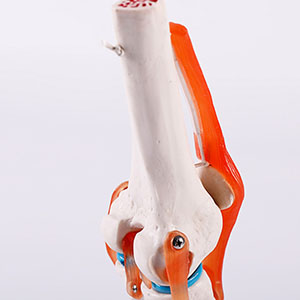Homepageпјҡ NEWS >> Can knee models improve the accuracy of diagnosis and treatment of knee diseases?
As an important part of body weight and movement, knee joint is prone to a variety of diseases, such as osteoarthritis, meniscus injury and ligament tear, due to its complex anatomical structure and greater pressure. The diagnosis and treatment of knee diseases often face high technical requirements, and the traditional imaging examination and clinical experience may have limitations in some complex cases. Can the introduction of knee joint models, especially 3D models with high precision anatomic reproduction, effectively improve the accuracy of diagnosis and treatment of knee diseases? This is a topic widely discussed in the medical field at present.
1. Knee joint model improves diagnostic accuracy

The diagnosis of knee joint diseases usually relies on imaging techniques (such as X-ray, CT, MRI) and clinical examination, but the imaging data itself often cannot fully present the three-dimensional structure and details of the knee joint, which may lead to misdiagnosis or missed diagnosis, especially in complex cases. The knee joint model visually presents the anatomical structure of the knee, so that doctors can understand various diseases of the knee joint in a more realistic three-dimensional space.
For example, the knee model can accurately simulate the articular surface, meniscus, ligaments and their relationships, which can help doctors identify minor cartilage injuries, ligament strains or meniscus tears. A 2020 study in the Journal of Orthopaedic Surgery and Research showed that doctors who used a knee model to assist in diagnosis were able to more accurately identify the site of injury before surgery, avoiding missing critical lesions in traditional imaging.
2. Knee joint model improves the accuracy of treatment plan

The treatment of knee diseases, especially surgery, often requires precise manipulation. Traditional surgery often relies on the doctor's experience, but anatomical differences can lead to different outcomes for different patients. Knee joint models, especially models that can simulate different lesions, can help doctors carry out more detailed preoperative planning and simulation before surgery.
Taking knee replacement surgery as an example, the knee joint model can help surgeons make personalized cutting and installation plans according to the actual knee anatomy of patients, reduce intraoperative errors, and thus improve the accuracy and success rate of surgery. A 2019 study published in Bone & Joint Journal found that patients who underwent preoperative planning with a 3D knee model had about 15% better functional recovery and significantly fewer postoperative complications than those in the conventional treatment group.
3. The role of knee joint model in patient education and communication

The treatment of knee diseases is not only the improvement of medical technology, but also involves the patient's understanding and cooperation with the condition. The knee joint model helps patients to understand their knee problems more intuitively through visualization, and enhances patients' trust and cooperation with the treatment plan.
In the treatment process, the knee joint model can make the patient clearly understand the specific location of the lesion and the treatment method, especially before complex surgery, the model can help the doctor communicate with the patient, eliminate the patient's fear of surgery, and improve the treatment effect. A 2021 survey in Clinical Orthopaedics and Related Research showed that doctors who used a knee model to communicate with their patients experienced significant improvements in both preoperative satisfaction and postoperative recovery.
4. Data support and clinical effect

Many studies have shown that the application of knee joint model not only improves the accuracy of diagnosis and treatment, but also has a positive impact on clinical treatment. In 2018, a retrospective study in the Orthopaedic Journal of Sports Medicine analyzed the clinical effects of using 3D models in knee surgery. The study found that the model helped surgeons to more accurately remove diseased tissue during arthroscopic knee surgery, reducing the occurrence of postoperative infections and complications, and reducing the postoperative recovery time of patients by about 20%.
In addition, the knee joint model can also play a role in precision injection therapy. For the treatment of intra-knee injections (such as hyaluronic acid, steroids), the model can provide a clearer anatomical reference, help doctors to accurately inject, avoid accidental injury to blood vessels or nerves, improve treatment effectiveness and reduce side effects.
5. Summary and outlook
In summary, the knee joint model undoubtedly plays an important role in improving the accuracy of diagnosis and treatment of knee diseases. By providing more intuitive and detailed anatomical and pathological simulations, knee models can help doctors more accurately diagnose diseases, develop personalized treatment plans, and improve patient preparation and postoperative rehabilitation. With the development of technology, future knee models may integrate emerging technologies such as virtual reality (VR) and augmented reality (AR) to provide more accurate and intelligent AIDS for the medical field.
With the continuous progress of medical technology, the application prospect of knee joint model in precision medicine and personalized treatment will be broader, promoting the treatment of knee diseases into a new era.